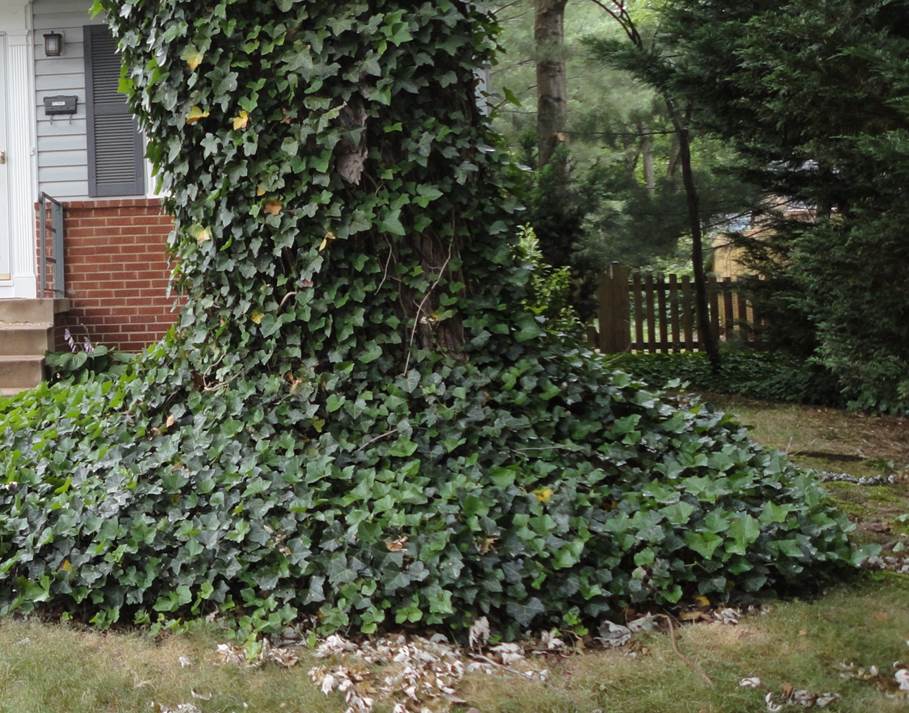The Destructive Impact of English Ivy on Trees and Structures in Victoria, BC
Destructive Impact of English Ivy
Need help with your yard? Get your free quote today!
Get a Free Quote!
English ivy's charming appearance masks its role as one of the most destructive forces threatening Victoria's trees and buildings. Property owners often don't recognize the severity of the threat until significant damage has occurred. Understanding how English ivy damages both trees and structures is crucial for protecting your property investment and our urban forest.
Critical Damage to Trees
The destruction of trees by English ivy follows a predictable but devastating pattern. Initially, the vine appears harmless as it begins climbing tree trunks. However, once established, it launches a multi-pronged attack that can kill even the largest, healthiest trees. The process starts with ivy vines encircling the tree trunk, creating a dense mat that traps moisture against the bark. This constant moisture exposure leads to bark rot and creates perfect conditions for harmful fungi and insects to infest the tree.
As ivy climbs higher, it begins its most dangerous phase of attack. Dense foliage creates a heavy canopy that can add several tons of weight to tree branches, significantly increasing the risk of failure during storms. This extra weight, combined with the sail-like effect of ivy leaves catching wind, makes affected trees particularly vulnerable to toppling or losing major limbs during Victoria's winter storms.
Perhaps most destructively, English ivy blocks essential sunlight from reaching the tree's leaves. Without adequate light, trees can't produce the energy they need through photosynthesis. This energy starvation leads to gradual decline, with trees producing fewer leaves each year until they can no longer sustain themselves. Professional arborists regularly observe trees that appear healthy from a distance but are actually dying under their blanket of ivy.
Structural Damage to Buildings
The damage English ivy inflicts on buildings often starts invisibly but can ultimately threaten structural integrity. Ivy's aerial roots penetrate even the smallest cracks in walls, growing larger over time and forcing these cracks to widen. This process accelerates dramatically during freeze-thaw cycles, as moisture trapped by ivy expands and contracts, gradually breaking apart mortar and concrete.
Recent assessments of affected Victoria properties reveal a disturbing pattern of damage. Ivy-covered walls often show significant mortar deterioration within just 2-3 years of initial growth. The cost of repairing this damage frequently exceeds $15,000 per wall, with some heritage properties facing restoration costs of over $50,000 due to the specialized materials and techniques required.
Foundation damage presents an even more serious concern. English ivy roots can penetrate foundation cracks, growing deeper and wider as they seek water. This root invasion compromises structural integrity and can create pathways for water infiltration into basements. The resulting water damage often leads to mold growth, compromised indoor air quality, and extensive repair needs.
Windows and doors face particular vulnerability to ivy damage. The vines work their way under frames, gradually forcing them out of alignment. This creates gaps that allow water infiltration and air leakage, leading to increased energy costs and potential water damage. Frame replacement costs typically range from $5,000 to $15,000 per affected area.
Roof structures suffer when ivy grows under shingles or other roofing materials. The lifting action creates entry points for water, leading to rot in roof decking and eventual leaks into living spaces. Complete roof replacement due to ivy damage can cost upwards of $20,000, not including interior repairs needed due to water damage.
The Hidden Costs
Beyond immediate structural damage, English ivy creates numerous secondary problems that increase property maintenance costs. Dense ivy growth provides ideal habitat for rodents, which can then access buildings through ivy-created entry points. The constant moisture retention against walls leads to paint failure, stucco deterioration, and accelerated aging of building materials.
For trees, the long-term costs extend beyond individual tree loss. When large trees fail due to ivy damage, they often cause significant collateral damage to properties and infrastructure. The cost of emergency tree removal combined with property repairs can easily exceed $25,000 per incident.
Professional Solution
Protecting trees and structures from English ivy damage requires professional intervention. Ascent Yard Care's comprehensive removal process ensures complete elimination of both visible growth and root systems while protecting valuable trees and building surfaces. Our specialized equipment and techniques allow for safe removal without causing additional damage to affected structures.
The most cost-effective approach is early intervention before significant damage occurs. However, even in cases of extensive invasion, professional removal provides immediate benefits by halting ongoing damage and preventing further deterioration. Our organic treatment methods ensure roots don't regenerate while protecting soil health and nearby desirable plants.
Contact Ascent Yard Care today for a free property assessment. Our expert team will evaluate the extent of ivy invasion on your property and develop a comprehensive removal plan that protects both your trees and structures. We serve all areas of Victoria, providing proven solutions that prevent costly damage and protect your property investment.
Remember: The cost of professional removal is a fraction of potential repair expenses. Don't wait until English ivy causes catastrophic damage to your trees and buildings. Trust Victoria's leading removal specialists to protect your valuable property assets.
